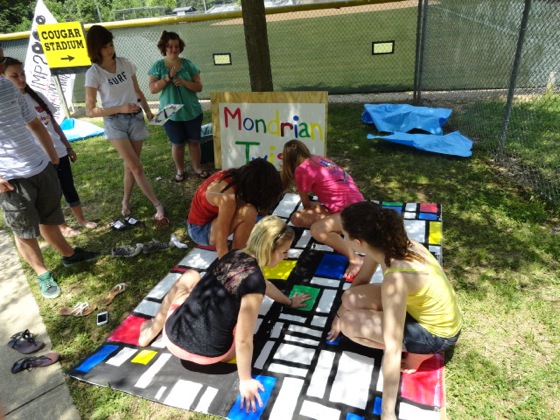When we talk about collaboration in the art room, many teachers’ minds, including my own, go straight to collaborative projects, with good reason. Murals, legacy projects, and installations are all effective ways to foster teamwork among students. However, collaboration goes much deeper than just working toward a common task. In fact, if the task is completely teacher-directed, then students are actually cooperating, not collaborating.
What is the difference between cooperation and collaboration?
The main difference between cooperation and collaboration is the final outcome. Cooperation means working together toward a common, defined goal. You could have students cooperate to hang 30 pieces of art in the hallway or cooperate to assemble a 10-foot tall sticky note mural. However, collaboration means working together to solve an open-ended, complex task. For example, students could collaborate to develop a mural or collaborate to design a legacy project for the school. The idea is that students will come up with better ideas by working together—that knowledge is formed and built-in social situations. Don’t get me wrong, often when students are collaborating, they are also cooperating, but the words do not mean the same thing.
So, how do we foster true collaboration in the art room?
If you stop and think about it, so much of the work being done in the world today depends on collaboration. With the rise of technology and globalization, workers from a single company may be scattered all around the world. This fact makes it imperative that our students know how to work with others with differing backgrounds, attitudes, and skill sets.
When thinking about incorporating any of the 4Cs into your classroom, a great place to start is the NEA’s document An Educator’s Guide to the “Four Cs.” This document asks the tough questions we need to ask ourselves when planning for 21st-century learning in our classrooms. For example, collaborative projects are great, but how else can we emphasize collaborative skills? How can we make sure our students are working in a variety of diverse teams? How can we, as teachers, effectively model these skills for students?
Here are four ways to start incorporating more collaboration.
1. Give students opportunities to work in diverse teams.
Assigning students to work in a variety of teams is one of the easiest ways to promote collaboration among students. The more peers students work with, the more viewpoints, ideas, and skill sets they will be exposed to. When disagreements come up, model effective listening and problem-solving skills. Highlight groups that successfully worked through problems. Remind students that to truly collaborate, there has to be a give and take.
Here are some suggestions to get started:
- Assign bellringers that have a collaborative element, like building the tallest tower from marshmallows and toothpicks in under five minutes.
- Design something for the classroom, like a new way to display rules or a new way to store a special supply.
- Work on collaborative projects on a variety of scales. Pair students up to work on an artwork together, create a one-class collaborative drawing, or have an entire grade level work on a month-long collaborative legacy piece.
- Switch students’ seats multiple times per grading period.
2. Give students open-ended, complex tasks.
The more complicated the problem, the more students will have to work together to come up with a solution. Remember, the theory is that students’ ideas are better together; generally, a group will come up with stronger ideas than an individual alone. So, think big!
Here are some suggestions to get started:
- Create an art installation in your community.
- Try a complex task like forced perspective.
- Design an entire carnival based on artists.
- Curate a living museum.
- Make art with unconventional materials.

3. Help students develop ownership of group projects.
At first, when you ask your students to work collaboratively, they may continue to come to you for direction. This is OK, but make sure you are not making decisions for them. In a collaborative project, the teacher does not decide the outcome. Instead, the teacher acts as a figure that empowers students to find their own outcomes. Therefore, your role will include consulting and giving suggestions, but reminding students that they are the ones in charge. This will help students invest in themselves and in their team members.
Here are some suggestions to get started:
- Ask open-ended questions.
- Help students find relevant research or resources.
- Model critical thinking.
4. Encourage collaboration among students outside of group work.
Sometimes we think that students can only collaborate when they are working toward a single goal, but this is false. It’s just as easy to have students work collaboratively on individual projects. Sound like an oxymoron? Let me explain. Since the goal of collaboration is to use group knowledge to come up with stronger ideas, why not have your students do collaborative brainstorming? Group brainstorming can be done at the beginning of a project or as an in-process critique. Once your students realize the power of collaboration, they’ll be more willing to share their ideas with others on a regular basis.
Here are some suggestions to get started:
- Try the interview technique mentioned in this article.
- Comment on one another’s blogs about in-process work.
- Use gallery walks to help students build ideas during work time.
- Build your students’ communication skills.
Having students work collaboratively in the art room has many positive outcomes. Students will learn to value teamwork as they work together to come up with stronger ideas. They will understand the value of working with people that have varying ideas and convictions. Working collaboratively will lead them to become better citizens and better prepared to take on the jobs of the future. Give it a try in your classroom. You’ll be amazed at the results!
How do you promote collaboration in your art room?
What ideas would you add to the lists?
Magazine articles and podcasts are opinions of professional education contributors and do not necessarily represent the position of the Art of Education University (AOEU) or its academic offerings. Contributors use terms in the way they are most often talked about in the scope of their educational experiences.





